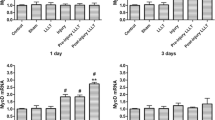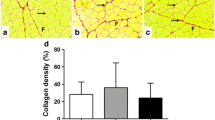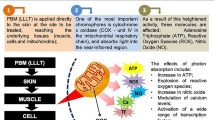Abstract
The aim of the present study was to evaluate the effects of LLLT prior to muscle injury with and without post-injury irradiation on the expression of isoforms of myosin heavy chain (MyHC), calcineurin (CaN), and myostatin during the repair process. Wistar rats were divided into five groups: control (n = 7); injury (n = 21); LLLT + injury (n = 21); injury + LLLT (n = 21), and LLLT + injury + LLLT (n = 21). Cryoinjury was performed on the tibialis anterior (TA) muscle. The injured groups were euthanized at 3, 7, and 14 days after injury. LLLT was performed using an infrared laser (780 nm) with the following parameters: 10 J/cm2, 40 mW, 10 s per point, 8 points, and 3.2 J of total energy. At the end of each period, the TA muscle was removed for the analysis of MyHC, CaN, and myostatin gene expression using real-time PCR. The data were tested statistically by Kruskal-Wallis with Dunn’s post hoc test (p < 0.05). The results demonstrated that prior irradiation reduced the mRNA expression of all proteins at 3 days. Post irradiation reduced the mRNA expression of MyHC-1, MyHC-2a, MyHC-2b, and CaN at 7 days. Prior irradiation combined with post-injury irradiation reduced the mRNA expression of MyHC-2x and CaN at 14 days and increased the mRNA expression of myostatin in the same period. In conclusion, different protocols of photobiomodulation can modulate the expression of the different isoforms of MyHC, CaN, and myostatin during the repair process. It is noteworthy that the combination of the prior and post-injury irradiation was the protocol that most promoted changes in the final phase of the repair process.


Similar content being viewed by others
References
Järvinen TA, Järvinen TL, Kääriäinen M, Kalimo H, Järvinen M (2005) Muscle injuries: biology and treatment. Am J Sports Med 33:745–764
Piovesan RF, Fernandes KP, Alves AN, Teixeira VP, Silva Junior JA, Martins MD, Bussadori SK, Albertini R, Mesquita-Ferrari RA (2013) Effect of nandrolone decanoate on skeletal muscle repair. Int J Sports Med 34:87–92
Souza TO, Mesquita DA, Ferrari RA, Dos Santos Pinto D Jr, Correa L, Bussadori SK, Fernandes KP, Martins MD (2011) Phototherapy with low-level laser affects the remodeling of types I and III collagen in skeletal muscle repair. Lasers Med Sci 26:803–814
Friday BB, Horsley V, Pavlath GK (2000) Calcineurin activity is required for the initiation of skeletal muscle differentiation. J Cell Biol 149:657–666
Naya FJ, Mercer B, Shelton J, Richardson JA, Williams RS, Olson EN (2000) Stimulation of slow skeletal muscle fiber gene expression by calcineurin in vivo. J Biol Chem 275:4545–4548
Michel RN, Chin ER, Chakkalakal JV, Eibl JK, Jasmin BJ (2007) Ca2+/calmodulin-based signalling in the regulation of the muscle fibre phenotype and its therapeutic potential via modulation of utrophin A and myostatin expression. Appl Physiol Nutr Metab 32:921–929
Kielbasa OM, Reynolds JG, Wu CL, Snyder CM, Cho MY, Weiler H, Kandarian S, Naya FJ (2011) Myospryn is a calcineurin-interacting protein that negatively modulates slow-fiber-type transformation and skeletal muscle regeneration. FASEB J 25:2276–2286
Fedoruk MN, Rupert JL (2008) Myostatin inhibition: a potential performance enhancement strategy? Scand J Med Sci Sports 18:123–131
Hennebry A, Berry C, Siriett V, O'Callaghan P, Chau L, Watson T et al (2009) Myostatin regulates fiber-type composition of skeletal muscle by regulating MEF2 and MyoD gene expression. Am J Physiol Cell Physiol 296:C525–C534
Choi YM, Kim BC (2009) Muscle fiber characteristics, myofibrillar protein isoforms, and meat quality. Livest Sci 122:105–118
Drzymala-Celichowska H, Karolczak J, Redowicz MJ, Bukowska D (2012) The content of myosin heavy chains in hind limb muscles of female and male rats. J Physiol Pharmacol 63:187–193
Ribeiro BG, Alves AN, Santos LA, Fernandes KP, Cantero TM, Gomes MT, et al (2015) The effect of low-level laser therapy (LLLT) applied prior to muscle injury. Lasers Surg Med 47:571–578
Ribeiro BG, Alves AN, Santos LAD, Cantero TM, Fernandes KPS, Dias DS et al (2016) Red and infrared low-level laser therapy prior to injury with or without administration after injury modulate oxidative stress during the muscle repair process. PLoS One 11:e0153618
Mesquita-Ferrari RA, Martins MD, Silva JA Jr, da Silva TD, Piovesan RF, Pavesi VC, Bussadori SK, Fernandes KP (2011) Effects of low-level laser therapy on expression of TNF-α and TGF-β in skeletal muscle during the repair process. Lasers Med Sci 26:335–340
Alves AN, Fernandes KP, Melo CA, Yamaguchi RY, França CM, Teixeira DF, Bussadori SK, Nunes FD, Mesquita-Ferrari RA (2014) Modulating effect of low-level laser therapy on fibrosis in the repair process of the tibialis anterior muscle in rats. Lasers Med Sci 29:813–821
Baptista J, Martins MD, Pavesi VC, Bussadori SK, Fernandes KP, Pinto Júnior Ddos S, Ferrari RA (2011) Influence of laser photobiomodulation on collagen IV during skeletal muscle tissue remodeling after injury in rats. Photomed Laser Surg 29:11–17
Alves AN, Fernandes KP, Deana AM, Bussadori SK, Mesquita-Ferrari RA (2014) Effects of low-level laser therapy on skeletal muscle repair: a systematic review. Am J Phys Med Rehabil 93:1073–1085
Fernandes KP, Alves AN, Nunes FD, Souza NH, Silva JA Jr, Bussadori SK, Ferrari RA (2013) Effect of photobiomodulation on expression of IL-1β in skeletal muscle following acute injury. Lasers Med Sci 28:1043–1046
Miyabara EH, Aoki MS, Soares AG, Moriscot AS (2005) Expression of tropism-related genes in regenerating skeletal muscle of rats treated with cyclosporin-A. Cell Tissue Res 319:479–489
Kim JP, Khalmuratova R, Jeon SY, Park JJ, Hur DG, Ahn SK et al (2011) Quantitative analysis of myosin heavy chain expression change in laryngeal muscle after irradiation in rats. Yonsei Med J 52:158–164
Vechetti IJ Jr, Aguiar AF, de Souza RW, Almeida FL, de Almeida Dias HB, de Aguiar Silva MA et al (2013) NFAT isoforms regulate muscle fiber type transition without altering CaN during aerobic training. Int J Sports Med 34:861–867
Ko IG, Jeong JW, Kim YH, Jee YS, Kim SE, Kim SH et al (2014) Aerobic exercise affects myostatin expression in aged rat skeletal muscles: a possibility of antiaging effects of aerobic exercise related with pelvic floor muscle and urethral rhabdosphincter. Int Neurourol J 18:77–85
Livak KJ, Schmittgen TD (2001) Analysis of relative gene expression data using real-time quantitative PCR and the 2(−Delta Delta C(T)) method. Methods 25:402–408
Oe M, Ojima K, Nakajima I, Chikuni K, Shibata M, Muroya S (2016) Distribution of tropomyosin isoforms in different types of single fibers isolated from bovine skeletal muscles. Meat Sci 118:129–132
Treviano MA, Herda TJ, Fry AC, Gallagher PM, Vardiman JP, Mosier EM, Miller JD (2016) Influence of the contractile properties of muscle on motor unit firing rates during a moderate contraction intensity in vivo. J Neurophysiol 116:552–562
Schiaffino S, Reggiani C (2011) Fiber types in mammalian skeletal muscles. Physiol Rev 91:1447–1531
Chin ER, Olson EN, Richardson JA, Yang Q, Humphries C, Shelton JM et al (1998) A calcineurin-dependent pathway controls skeletal muscle fiber type. Genes Dev 12:2499–2509
Sakuma K, Yamaguchi A (2010) The functional role of calcineurin in hypertrophy, regeneration and disorders of skeletal muscle. J Biomed Biotechnol 2010:721219
Boff SR (2008) The muscle fiber and the factors that interfere with its phenotype. Acta Fisiátrica 15:111–116
Funding
This work was supported by UNINOVE and the Brazilian fostering agency, São Paulo Research Foundation—FAPESP (grants: 2013/21540-3, 2014/12381-1, and 2017/06461-0).
Author information
Authors and Affiliations
Corresponding author
Ethics declarations
Conflict of interest
The authors declare that they have no competing interests.
Ethical approval
This study received approval from the Ethics Committee on Animal Research of University Nove de Julho (process number: AN25/2014), and all experiments were performed in accordance with the guidelines of the Brazilian National.
Rights and permissions
About this article
Cite this article
De Lima Rodrigues, D., Alves, A.N., Guimarães, B.R. et al. Effect of prior application with and without post-injury treatment with low-level laser on the modulation of key proteins in the muscle repair process. Lasers Med Sci 33, 1207–1213 (2018). https://doi.org/10.1007/s10103-018-2456-2
Received:
Accepted:
Published:
Issue Date:
DOI: https://doi.org/10.1007/s10103-018-2456-2




